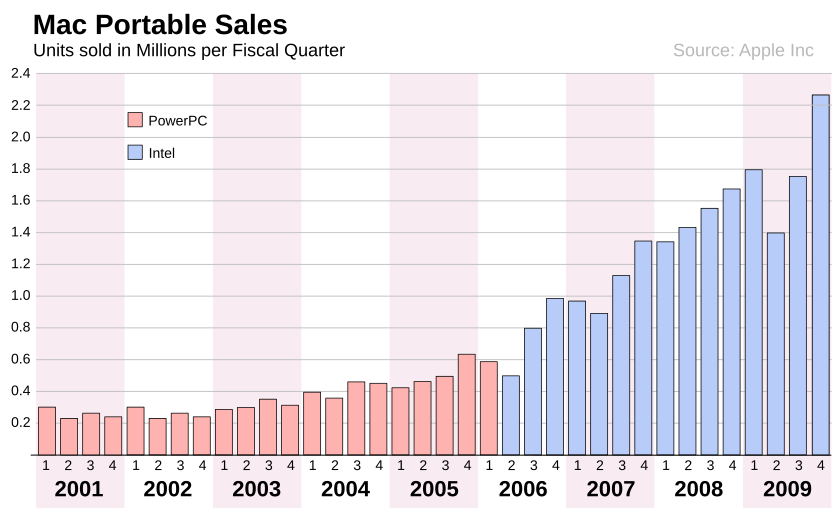Back in 2005 when Steve Jobs announced the transition from IBM Power PC chips to Intel PC chip [yep same one that were and are used in Windows-based PCs], the Mac community was flabbergasted. Many raised the question how were Macs going to distinguish themselves from Windows PCs now that nearly everything was the same but the operating system. Some said this was an opportunity for Redmond to finally run Macs out of PC town with their upcoming Longhorn upgrade.
Apple’s Steve Jobs insisted that the performance uptick with greater battery life more than justified the transition by itself. The rumor mill boiled down to three main reasons beyond “better performance”:
1)An Intel chip would allow quick boot switch from Mac to Windows – and BootCamp arrived within 1/2 year to do so;
2)Intel would be able to offer a better chip price to Apple because now it would have 2M/year chips that were “gravy”;
3)And so Apple would be able to offer Macs for prices within 20-40% of PCs.
And as the chart above shows, after the very fast transition from PowerPC to Intel chips between June 2005 to August 2006 Apple’s portable sales took off despite the 2008-2009 recession. Oh and despite the fact that during this latter period Apple’s Macs were selling not at a 20-40% premium to the equivalent equipped Windows but 100% to 300% more. Given the disaster that was and is Vista and Windows 7 during the same period, Apple threw away the huge opportunity to gain market share over PCs.
The Lost Opportunity
By all standards Vista was and is not a WOW but a WWO [pronounced “woe”] World’s Worst OS. A truncated version of the major revision that was Longhorn, Vista was thrown out well before even the second job of baking was done. The litany of WWOs are many and well documented:
1)Slower than Windows XP by a factor of 25-50% in tests on identically the same machine;
2)Such a change from Windows XP and predecessors, that there was/is a significant learning curve;
3)Still plagued with lingering reliability problems – “reboot to get Windows working again”;
4)Bloated memory usage and requirements comes up against laptops with 1 or 2GB memory ceilings;
5)Plagued with incompatibilities with existing peripherals, hardware and software;
6)Security already shaky gets completely turned off because it is so intrusive.
Consumers were not given a chance to decide because Windows XP in June 2008 the not allowed to be sold; but large organizations were allowed to choose and they voted overwhelmingly against Vista and chose to stay with Windows XP .
This represented a juicy opportunity for Apple and their TV ads certainly indicated they knew it in 2007:
But for reasons unknown and unfathomable Apple from 2007 [during the height of the Vista problems] did not lower their prices for Macs but raised them. I know because I wanted to buy a Mac laptop but found the price of a Mac at more than 100% more of the equivalent PC too expensive . I knew my clients would demand Windows capabilities and that would entail substantial investments in time and money in getting Parallels to work effectively in Mac with Windows XP. That ritual I just did not have time for. But I have continued to watch Mac versus PC prices and today they are even worse:
Apple – Dual Core CPU 2.5GHz, 15in screen , 4GB RAM, 320GB hard disk – $2000US
Toshiba – Dual Core CPU 2.5GHz, 16in screen, 4GB RAM, 640GB hard disk – $800US
The price has drifted up to 250% greater not for the equivalent PC but one that bests Mac with double the hard drive space and a larger screen. But give Steve Jobs credit he was not the only one to spurn this opportunity to gain significant market share from Microsoft and Windows PC – the Linux and VM communities also fumbled the chance for market gains as well.
Summary
So having passed on the opportunity to gain significant market share in the desktop and laptop markets, Steve Jobs may have decided to be more price conscious given whatever motivates the man these days. And so instead of the rumored $1000 price for the iPad – Steve started out at $499 for the basic machine [- some argue that $630 is the base price because no one is going to want to buy an iPad without 3G]. But that $499 price acts as a bar – this is what the market of new Netbooks, Smartphones, eReaders and even most laptops will have to break if they want to be successful. This in turn will put even more pressure on Windows pricing – consumers are going to look at the in store price of Windows at $150 to 350 [I know Redmond’s price to OEMs is much less at $60-100, but most consumers don’t know that]. So consumers like more corporates [businesses are looking in askance at their large Microsoft Assurance contracts given that they now spend 80% of their budgets to just to operate and maintain systems] will be looking for better bargains. And this time not just Apple, but Google and a ton of Asian hardware players with Chrome OS and Android will be offering devices at well under the $499 bar.
So two years late, Steve Jobs makes partial amends for pricing his Macs so high such that Microsoft and PC vendors at 1/3th price in crushing economic times have gotten the last laugh at Jobs and his annoying Apple TV commercials.

